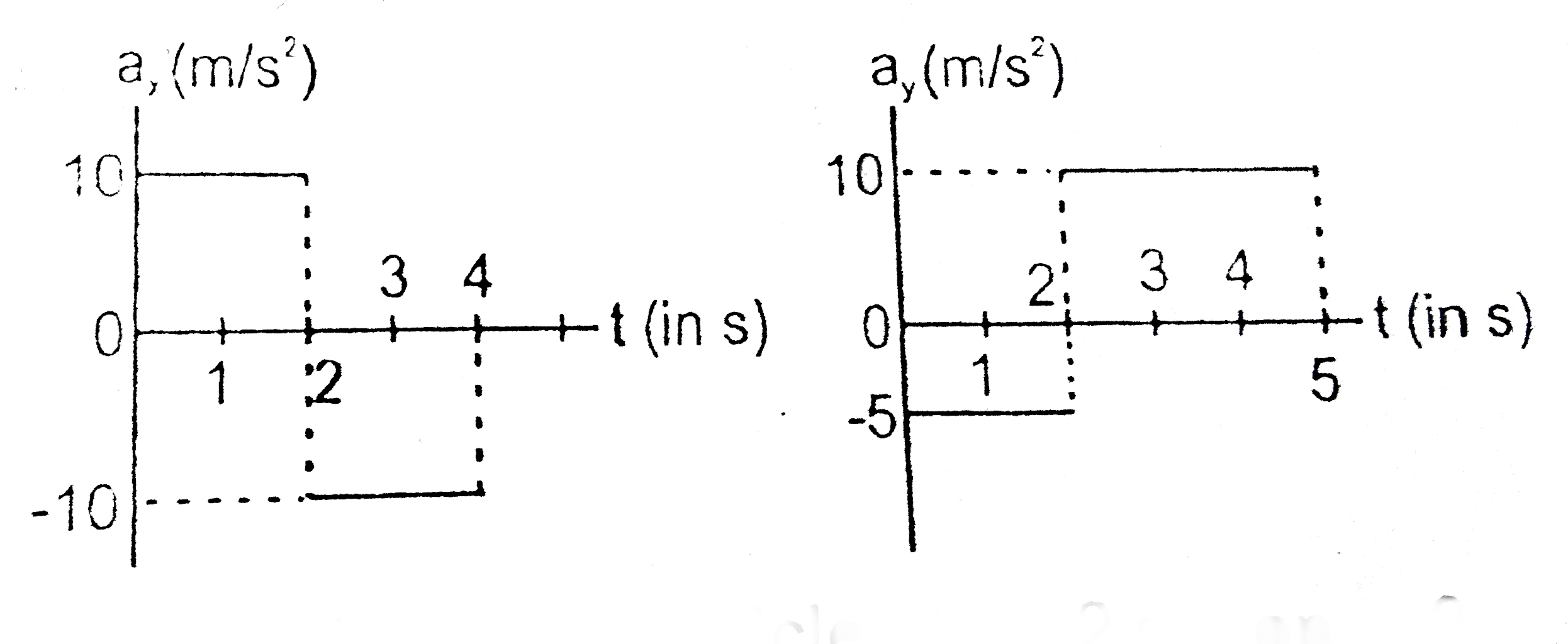The position of a particle x (in meters) at a time t seconds is given by the relation →r=(3tˆi−t2ˆj+4ˆk). Calculate the magnitude of velocity of the particle after 5 seconds
3.55
5.03
8.75
10.44
The correct Answer is:D
To solve the problem, we need to calculate the magnitude of the velocity of the particle after 5 seconds, given the position vector →r=(3t^i−t2^j+4^k).
Step 1: Find the velocity vector
The velocity vector →v is the time derivative of the position vector →r. Therefore, we differentiate →r with respect to time t.
→v=d→rdt=ddt(3t^i−t2^j+4^k)
Step 2: Differentiate each component
Now we differentiate each component of the position vector:
1. The ^i component:
ddt(3t)=3
2. The ^j component:
ddt(−t2)=−2t
3. The ^k component:
ddt(4)=0
Combining these results, we get the velocity vector:
→v=3^i−2t^j+0^k
Step 3: Substitute t=5 seconds into the velocity vector
Now we substitute t=5 seconds into the velocity vector to find the velocity at that time:
→v(5)=3^i−2(5)^j+0^k
→v(5)=3^i−10^j
Step 4: Calculate the magnitude of the velocity vector
The magnitude of the velocity vector →v is given by:
|→v|=√(vx)2+(vy)2+(vz)2
Substituting the components:
|→v|=√(3)2+(−10)2+(0)2
|→v|=√9+100+0=√109
Step 5: Calculate the numerical value
Now we calculate √109:
|→v|≈10.44 m/s
Final Answer
The magnitude of the velocity of the particle after 5 seconds is approximately 10.44 m/s.
---
The velocity vector →v is the time derivative of the position vector →r. Therefore, we differentiate →r with respect to time t.
Now we differentiate each component of the position vector:
ddt(3t)=3
ddt(−t2)=−2t
ddt(4)=0
→v=3^i−2t^j+0^k
Now we substitute t=5 seconds into the velocity vector to find the velocity at that time:
→v(5)=3^i−2(5)^j+0^k
→v(5)=3^i−10^j
The magnitude of the velocity vector →v is given by:
|→v|=√(vx)2+(vy)2+(vz)2
Substituting the components:
|→v|=√(3)2+(−10)2+(0)2
|→v|=√9+100+0=√109
Now we calculate √109:
|→v|≈10.44 m/s
The magnitude of the velocity of the particle after 5 seconds is approximately 10.44 m/s.
Topper's Solved these Questions
- BOOK - ERRORLESSCHAPTER - MOTION IN ONE DIMENSIONEXERCISE - NCERT BASED QUESTIONS (RELATIVE MOTION )18videos
MOTION IN ONE DIMENSION
- BOOK - ERRORLESSCHAPTER - MOTION IN ONE DIMENSIONEXERCISE - NCERT BASED QUESTIONS (MOTION UNDER GRAVITY )56videos
MOTION IN ONE DIMENSION
- BOOK - ERRORLESSCHAPTER - MOTION IN ONE DIMENSIONEXERCISE - NCERT BASED QUESTIONS (UNIFORM MOTION )24videos
MOTION IN ONE DIMENSION
- BOOK - ERRORLESSCHAPTER - KINETIC THEORY OF GASES EXERCISE - ASSERTION AND REASON16videos
KINETIC THEORY OF GASES
- BOOK - ERRORLESSCHAPTER - MOTION IN TWO DIMENSIONEXERCISE - ASSERTION & REASON19videos
MOTION IN TWO DIMENSION
Similar Questions
The position of a particle is given by →r=(8tˆi+3t2+5ˆk) m where t is measured in second and →r in meter. Calculate,
the magnitude of velocity at t = 5 s,View SolutionA particle starts from origin with uniform acceleration. Its displacement after t seconds is given in metres by the relation x=2+5t+7t2
Calculate the magnitude of its (i) initial velocity (ii) velocity at t =4 s (iii) uniform acceleration (iv) displacement at t =5 s.View Solution
Knowledge Check
- Question 1 - Select One
The position vector of a particle at time t is given by →r=2tˆi+5tˆj+4sinωtˆk where ω is a constant.Answer the following questions
Velocity vector of the particle isAConstant in magnitude but variable with directionBconstant in direction must variable with magnitudeCconstantDVarying with magnitude as well as direction - Question 2 - Select One
If the displacement x of a particle (in metre) is related with time (in second) according to relation
x=2t3−3t2+2t+2
find the position, velocity and acceleration of a particle at the end of 2 seconds.A10m;14m/s;10m/s2B18m;14m/s;18m/s2C14m;112m/s;18m/s2D10m;14m/s;18m/s2 - Question 3 - Select One
The position vector of a particle at time t is given by →r=2tˆi+5tˆj+4sinωtˆk where ω is a constant.Answer the following questions
Acceleration of the particle isAConstant in magnitude but variable with directionBconstantCConstant in direction but variable with magnitudeDVarying with magnitude as well as direction
A particle starts from origin with uniform acceleration. Its displacement after t seconds is given in meter by the relation x=2+5t+7t2. Calculate the magnitude of its
a. Initial velocity
b. Velocity at t=4s
c. Uniform acceleration
d. Displacement at t=5sView SolutionA particle starts from rest with a unifor acceleration. Its displacement x after x seconds is given in metres by the relation x=5+6t+7t2
Calculate the magnitude of its (i) initial velocity (ii) velocity att=3s (iii) uniform acceleration and (iv) displacement at t= 5 as.View Solutionthe distance s meters travelled in time t second by a car is given by the relation s=3t2 then find the velocity of the car at time t=4 seconds.
View SolutionThe position vector of a particle is determined by the expression →r=2t2ˆi+3tˆj+9ˆk. The magnitude of its displacement ( in m) in first two seconds is
View SolutionA particle which is initially at rest at the origin, is subjection to an acceleration with x− and y− components as shown. After time t=5 , the particle has no acceleration.

What is the magnitude of velocity of the particle at t=2 seconds ?View Solution

